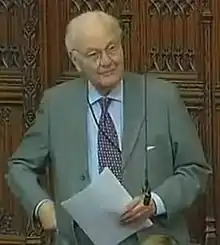Jack Lewis, Baron Lewis of Newnham
Jack Lewis, Baron Lewis of Newnham, FRS,[1] HonFRSC (13 February 1928 – 17 July 2014) was an English chemist working mainly in the area of inorganic chemistry.
The Lord Lewis of Newnham | |
|---|---|
 | |
| Born | 13 February 1928 |
| Died | 17 July 2014 (aged 86) |
| Nationality | British |
| Alma mater | University of London University of Nottingham |
| Awards |
|
| Scientific career | |
| Fields | Chemistry |
| Institutions | University of Sheffield Imperial College London University of Manchester University College London University of Cambridge |
| Doctoral students | Kevin Burgess |
Education and personal life
Educated at Barrow Grammar School, he graduated in 1949 with a bachelor's degree in chemistry from the University of London, after which he moved to the University of Nottingham where he obtained his Ph.D.
In 1951 he married Elfreida "Freddie" Lamb (1928-2023). They had one son and one daughter.[2]
Professional career
In 1953 he was appointed lecturer at the University of Sheffield before returning to London in 1956 as a lecturer at Imperial College London. He was Professor of Chemistry at the University of Manchester from 1961 to 1967, University College London from 1967 to 1970, and the University of Cambridge from 1970 to 1995. He was also the first Warden of Robinson College, the newest of the Cambridge colleges, from its foundation in 1977 until 2001.[2]
He was elected a Fellow of the Royal Society (FRS) in 1973[1][3] and was awarded their Davy Medal in 1985,[4] and their Royal Medal in 2004.[5] He was also an Honorary Fellow of the Royal Society of Chemistry,[6] and its president from 1986 to 1988.[7] He was a member of the American Academy of Arts and Sciences,[8] the National Academy of Sciences,[9] and the American Philosophical Society.[10]
24_2-.png.webp)
He was knighted in 1982[11] and created Baron Lewis of Newnham of Newnham in the County of Cambridgeshire on 8 February 1989.[12] He was a member of the House of Lords, where he sat as a cross bencher and was a member of a number of Select Committees on Science and Technology. He was also a member of the Advisory Council for the Campaign for Science and Engineering.[13] In 1993, he was made an Honorary Fellow of the University of Central Lancashire.[14] In 1995, he was awarded an Honorary Degree (Doctor of Science) by the University of Bath.[15] In 1998 he became the fourth Chairman of the Standing Committee on Structural Safety, serving until 2002.
Scholarship
Lewis's early career was dedicated to magnetic properties of metal complexes. He achieved significant acclaim for contributions to metal carbonyl clusters. Together with his longtime collaborator Brian F. G. Johnson, his research group discovered many structurally unusual compounds. Illustrative of their achievements is their synthesis of super tetrahedron [Os10C(CO)24]2−.[16]
Legacy
When Lewis died, Robinson College flew its flag at half mast.[17] A memorial service in his memory was held in the college's chapel on 28 February 2015,[17] the day after a symposium on his work, chaired by Emeritus Professor Brian Johnson.[18] A staircase erected in his honour in the chapel is inscribed with his name and the words "his wisdom shaped this college".[17] Donations in his memory were used to create the "Lewis Research Studentship in Chemistry", a three-year graduate studentship in Chemistry at Robinson College.[18]
References
- Clark, Robin J. H.; Raithby, Paul R. (2016). "Jack Lewis, Baron Lewis of Newnham HonFRSC. 13 February 1928 — 17 July 2014". Biographical Memoirs of Fellows of the Royal Society. 62: 299–322. doi:10.1098/rsbm.2015.0022. ISSN 0080-4606.
- Black, A (1974). Who's Who. London: A. & C. Black. ISBN 9780713613773.
- "Fellows". The Royal Society. Archived from the original on 7 October 2010. Retrieved 10 October 2010.
- "Davy archive winners 1989-1900". Royal Society. Archived from the original on 13 October 2007. Retrieved 9 October 2007.
- "Royal recent winners". Royal Society.
- "Deaths". RSC News. Royal Society of Chemistry: 23. October 2014.
- "404 – Anglia Ruskin University". Archived from the original on 22 December 2012. Retrieved 21 April 2015.
{{cite web}}: Cite uses generic title (help) - "Jack Lewis". American Academy of Arts & Sciences. Retrieved 10 February 2022.
- "Jack Lewis". www.nasonline.org. Retrieved 10 February 2022.
- "APS Member History". search.amphilsoc.org. Retrieved 10 February 2022.
- "No. 48939". The London Gazette. 2 April 1982. p. 4588.
- "No. 51643". The London Gazette. 13 February 1989. p. 1851.
- "Advisory Council of the Campaign for Science and Engineering". Archived from the original on 28 August 2010. Retrieved 11 February 2011.
- "Honorary Fellows". uclan.ac.uk. University of Central Lancashire. Retrieved 15 January 2015.
- "Honorary Graduates 1989 to present". bath.ac.uk. University of Bath. Archived from the original on 17 July 2010. Retrieved 18 February 2012.
- Jackson, Peter F.; Johnson, Brian F. G.; Lewis, Jack; Nelson, William J. H.; McPartlin, Mary (1982). "The synthesis of the cluster dianion [Os10C(CO)24]2− by pyrolysis. X-Ray structure analysis of [N(PPh3)2]2[Os10C(CO)24] and [Os5C(CO)14H(NC5H4)]". Journal of the Chemical Society, Dalton Transactions (10): 2099. doi:10.1039/DT9820002099.
- Gamlen, G (April 2015). "A Great Man". RSC News. Royal Society of Chemistry.
- "Lord Lewis Memorial Symposium". University of Cambridge. Retrieved 21 April 2015.